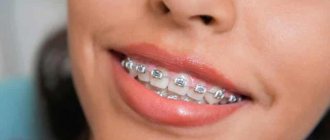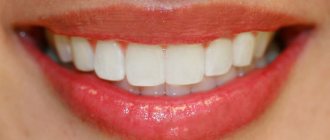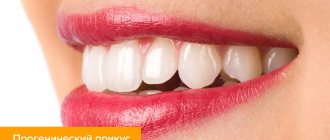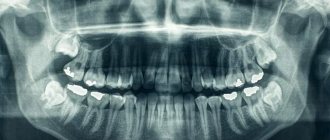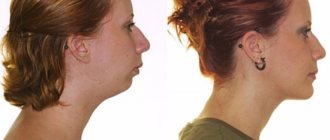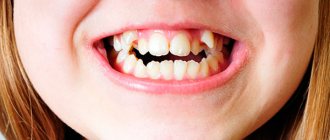- Signs of correct bite
- Types of malocclusion
- Why do you need to correct your bite?
- Until what age can a bite be corrected?
- Ways to correct a bite
- Aligners
- Trainers
- Veneers
- Bracket system
- Types of braces
- Which braces system should you choose?
- How long does it take to correct a bite?
- How to care for braces?
Malocclusion occurs in almost 80% of the Russian population. In a third of cases it requires orthodontic treatment. And it’s not just a matter of aesthetics - if you are often bothered by headaches, earaches and dizziness, then perhaps it’s a malocclusion. An orthodontist deals with the correction and prevention of malocclusions.
The most common misconception about bite is related to age. Many people think that it can only be corrected in childhood, but today, with the advent of new technologies, this can be done at any age.
In this article we will look at the causes and types of malocclusion and why it needs to be corrected. We will also tell you about treatment methods and dispel the most common fears. Orthodontist Olesya Milagina comments on current issues of orthodontic treatment for us.
Installation of braces in adulthood
Orthodontic treatment with braces in Russia goes back about thirty years. And in the USA, for example, bite correction with braces has been practiced for more than a hundred years. Russian orthodontists today often work with adults who simply did not have the opportunity to undergo this level of treatment in childhood. As a rule, such patients themselves turn to the dentist, less often - through the referral of related specialists. As a rule, people come to orthodontists for a beautiful smile, and not because of any pain. Most of those applying are women. Men are more relaxed about imperfect smiles, although doctors have recently noted an increase in the number of male patients.
Bite and headache
There are many causes of headaches. One of them is the condition of the temporomandibular joint, which is disrupted due to the formation of malocclusion. The upper jaw completes its development quite early. The bones that form it stop growing by the age of 16. The lower one increases in size for about 5 more years. This is accompanied by a change in the position of the head and disc of the lower jaw joint.
In the area of the temporomandibular joint there are a large number of vessels and nerves that are compressed when the head is displaced. Also, changing the position of the lower jaw leads to increased muscle tone in the lower third of the face and neck. All this together becomes the background for the development of migraines and dizziness.
Does it make sense to get braces as an adult?
Correcting a pathological bite or incorrect position of teeth is, of course, not a matter of life and death. Rather, it is a matter of regaining self-confidence. The “curvature” of teeth has little effect on communication; after all, we perceive a person holistically, and not solely the state of his bite. But, you see, an open wide smile of any person will make him more attractive in our eyes. And only people who are not embarrassed to show off their teeth smile like that. Plus, when we talk about bite, it's not just about beauty, it's also about functionality. Nature intended that when chewing, the load on the teeth should be distributed evenly - this is only possible with straight teeth and a healthy bite. If this is not the case, then over time a person develops problems with the dental system: pain appears, clicks when opening and closing the mouth, etc. Therefore, orthodontic treatment for adult patients is not only possible, but also necessary.
Types of malocclusion
How can you tell if your bite is wrong? Essentially, these are all deviations from the norm that nature has established.
Malocclusion occurs:
- distal - the upper jaw is pushed forward more than the lower jaw;
- mesial - the lower jaw is pushed forward more than the upper jaw;
- deep - the upper teeth overlap the lower ones by more than half their length;
- open - most of the teeth of the upper and lower jaws do not meet;
- cross - the left and right sides of the upper dentition protrude forward unevenly, and the upper and lower teeth meet with cutting edges.
At what age does it make sense for adults to get braces?
In any case, there are no age restrictions. There are surmountable obstacles: the general condition of the teeth, periodontal and gum diseases, and possible common concomitant diseases. Absolute contraindications for installing braces for adults coincide with many other types of treatment: lack of teeth, tuberculosis, diabetes, a number of immune diseases, epilepsy, bone pathologies, blood diseases. If a person gets braces when he is over thirty, the treatment will be quite long, since tissue regeneration occurs more slowly due to age. Plus, skeletal growth has already been completed, and the position of the bones can be “corrected” only when they are still growing - in childhood and adolescence. However, dentists achieve excellent results with mature patients.
Methods of therapy for correcting bite
Correcting a bite most often means exclusively wearing braces. Indeed, they are often used (and not only for children), but other methods are also used in orthodontics. They can be divided into two groups - surgical and non-surgical.
Surgical methods
Surgical intervention is necessary in three cases:
- when there is high crowding, when it is necessary to remove quarter premolars to make room for other teeth;
- with serious jaw abnormalities;
- to speed up treatment.
Severe pathologies of the jaw bones, which lead to malocclusion and disturbances in swallowing and breathing, cannot be corrected without surgery. During the operation, the surgeon cuts the bone tissue in the places where the teeth need to be moved. At this time, the patient is under general anesthesia in the inpatient department. Rehabilitation after surgery takes up to three weeks. After the tissues are restored, the jaw will have to be developed. Most often, additional treatment is required: the doctor prescribes braces, which must be worn for at least six months. The type of braces, duration of wearing them, and location depend on the current state of the bite.
Surgery can also be used to shorten the treatment time for malocclusion. Orthodontists use what is called a corticotomy, a small operation performed after braces are installed.
About a week after installation, the patient comes to the periodontist, who uses a piezotome to make small incisions in the gums. The entire operation takes about 30 minutes and is performed under local anesthesia. Occasionally, sedatives are also used - general anesthesia is usually not needed.
After corticotomy, the patient will have to visit the orthodontist and periodontist several more times to remove sutures, monitor the condition of the gums and correct the braces. The operation significantly speeds up treatment – by 3–6 months.
Important: surgical intervention is prescribed only in adulthood, after the jaw is fully formed (usually after 16 years). There are a number of standard contraindications: HIV, cancer, heart disease, etc.
Treatment without surgery
If we are not talking about serious pathologies of the jaw, orthodontists and their patients do without surgical treatment methods. Correction of the bite occurs through the installation and long-term wearing of braces, mouthguards and other devices.
Braces are the most effective way to eliminate pathology. They are a power arch with brackets that are secured to the teeth. The arch provides constant pressure on the teeth, and they gradually move, taking the right place.
Braces are worn without interruption. They are removed only at an appointment with the orthodontist, during correction. Over the entire period of treatment (which ranges from 6 months to 3 years), several visits to the doctor may be required. The procedure and duration of treatment depend on the condition of the teeth and the chosen braces system. Thus, self-ligating ones do not require too frequent visits to the orthodontist.
In addition to braces, there are other methods of therapy. Thus, mouthguards are often used - removable devices made of transparent material, and if we are talking about three, microprosthetics (veneers) are chosen.
Specifics of treatment with braces in adults
Adult patients should keep in mind that it is often necessary to remove teeth to achieve a high-quality result of orthodontic treatment. This does not mean that every patient needs it; removal is carried out only in cases where there is not enough space to restore the normal position of the teeth. Foreign orthodontists change the jaw size of adults using surgery. In Russia, orthognathic surgery is not yet particularly widespread due to the fact that our patients are extremely reluctant to agree to undergo operations. Let us repeat that this is just information about how it might be. In most cases, orthodontic treatment for adults is limited to simply installing braces.
Enamel deteriorates due to braces
When correcting a bite, braces are fixed to the surface of the enamel, and it stops being washed with saliva. This may weaken it, but with proper dental care and sufficiently effective self-hygiene, dental health is not in danger. To ensure that teeth remain healthy after bite correction, remotherapy is carried out before installing braces, professional hygiene is periodically performed during the treatment period, and the condition of the teeth is regularly monitored.
Which braces are most often installed in adults?
It is most rational to choose metal braces: they are the most durable, and since the treatment will be long, this is one of the most important indicators. When it comes to minor corrections, aesthetic systems made of ceramics or artificial sapphires can be installed. But, let’s say, ceramic braces are quite fragile compared to metal ones. If the ceramic lock is chipped, you will need to remove it and install a new one. And this is a waste of time: when the lock is re-glued, the treatment can be considered to begin anew. When choosing a brace system, it is best to listen to the orthodontist’s recommendations - the doctor selects or combines types of structures so that the treatment is as comfortable as possible.
Pros and cons of braces
The system has many advantages. The main ones:
- Quickly fix the problem. To achieve the desired effect, long-term treatment is not necessary; the dental units take the correct position in a short period of time. This especially applies to structures made of metal.
- Many indications when the use of staples is applicable. These include both minor deviations and severe malocclusions that do not require surgical intervention.
- Possibility to combine with other therapeutic methods. Correction is applied individually or in combination, it all depends on the individual characteristics of the patient and the severity of the pathological process.
Flaws:
- External systems are visible to the naked eye. Even if you choose the most aesthetic options, they will still be noticeable to others. However, nowadays, orthodontic appliances have become a fashionable accessory, which indicates that the owner cares about his health. There are also lingual braces, hidden and unnoticeable.
- More careful oral hygiene is required. If you do not devote enough time to care, plaque will begin to accumulate and tartar will form. Professional cleaning in a dental office is recommended at least 3 times a year.
- Possibility of injury to mucous membranes (tongue, inner cheeks, gums). In the first time after installation, this phenomenon is not uncommon. But patients get used to the discomfort. In addition, you can purchase special wax to seal traumatic elements.
- Diet restrictions. This diet involves avoiding hard, viscous and sticky foods. Otherwise, the structure will quickly become unusable, and the duration of therapy will increase significantly.
Is it possible to correct an adult's bite without braces?
You can - with the help of aligners. These are orthodontic transparent aligners made of solid polymer. Despite their rather simple appearance, aligners cope well with both minor changes in the position of the teeth and quite serious pathologies of the dentofacial apparatus. When treating with orthodontic aligners, patient motivation is extremely important. Aligners are more often chosen by men - they think that this type of treatment is less problematic. But they often lack patience and remove the aligners as soon as they feel discomfort. And this is unacceptable if the patient expects a positive effect of treatment. Aligners need to be worn 22 hours a day - keep this in mind before choosing this treatment option. If you comply with this requirement, then treatment with braces will not be necessary - mouthguards are no less effective at restoring the anatomically correct position of the teeth and correcting the bite.
Signs of correct bite
To begin with, we will show what a normal bite looks like and list the signs by which you can understand that it is normal.
- The main distinguishing feature of a correct bite is the tight contact of the upper and lower jaws when they close. The upper front teeth cover the crowns of the lower ones by a third, that is, the lower incisors come into contact with the palatine tubercles of the upper ones. There is no distance between the upper and lower chewing teeth, and during chewing they are in constant contact.
- Correct bite affects the harmony of facial proportions: the lower and upper jaws are symmetrical.
- There are no speech defects.
- Food is comfortable to bite and chew.
- There is no discomfort or clicking in the jaw joint.
What are the best “adult” braces according to reviews?
Most adult patients respond positively to lingual braces. They are fixed on the back surface of the teeth and are absolutely invisible to others. This type of braces has the lowest profile: the clasps of the systems are lower than all others, and therefore do not interfere with diction, do not irritate the mucous membranes, and do not scratch the tongue. Adults also often choose non-ligature ceramic braces - they are practically invisible, quite durable and cheaper than sapphire structures. When choosing a vestibular system that is fixed on the front surface of the teeth, it is worth considering that no matter what invisible material its clasps are made of, the orthodontic arch will always be noticeable. Therefore, you can safely choose classic metal braces. Ultimately, preference for a particular design comes down to its price.
Orthodontics at the Dent Ideal clinic
By choosing our clinic, you are choosing dentistry that keeps up with the times. Our specialists know the importance of a beautiful and healthy smile for every person - this is one of the main steps to success in any direction.
The clinic uses new technologies and has an experienced team of orthodontists who work with standard and complex cases. Our doctors do not rest on their laurels and regularly improve their skills and use innovative technologies recognized throughout the world. In our medical center, European service awaits you; with us you will get exactly the result you expected!
Retainers: why are they worn after braces are removed?
A retainer is a device that looks like an arch. It is placed on the back surface of the teeth when braces are removed. This way the new position of the teeth is secured. The ligamentous apparatus of the teeth has muscle memory, so no matter how we move the teeth, they will tend to return to their “original” position. Wearing a retainer is an essential part of orthodontic treatment. This is especially true for people over twenty-five years of age. A retainer is installed for at least two periods of wearing braces: for example, the patient wore them for one year, then the retainer will need to be worn for two years. Foreign orthodontists generally argue that you need to wear retainers constantly - this is the only way to guarantee that your teeth will remain straight. In general, after some time the retainer can be replaced with a night guard or plate. But some kind of structure supporting the new position of the teeth will definitely be needed - this is a classic. Unfortunately, patients often neglect this stage of treatment, experience relapses and begin to talk about the ineffectiveness and uselessness of orthodontic treatment in adulthood.
How much does treatment cost?
The cost of correcting a bite largely depends on:
- condition of the oral cavity (if caries is treated, inflammation is eliminated, the price increases);
- materials that will be used for the manufacture of orthodontic systems;
- technologies used by clinic doctors.
To get a quote, it is better to contact an orthodontist, who will examine the oral cavity, select the optimal technology together with the patient, and draw up a treatment plan. Doctors at our clinic can give an objective assessment of the condition of your teeth. During the consultation, the orthodontist will answer all your questions and tell you what stages of treatment will be used in a particular case. To make an appointment, call us or write through the feedback form.
How long should adults wear braces?
It is impossible to answer this question unambiguously: maybe one year, or maybe several years. Bite correction in adult patients is a long, labor-intensive process that requires patience and discipline. Therefore, orthodontists rarely persuade adults to straighten their teeth. If a person himself does not want this, then nothing will force him to conscientiously fulfill all the doctor’s demands. When treating adults with orthodontics, it is important that the dentist find a compromise between what he wants to achieve and what the patient wants to achieve. Orthodontists, of course, always strive to restore the perfectly aligned position of teeth, no matter how long it takes - at least three years, at least five years. The patient may get tired of the treatment and abandon it. The dentist’s main task is to honestly tell you how long the treatment will take and how it will proceed. And then hear whether the patient is ready to go this route.
How often is orthodontic treatment needed?
As an orthodontist with more than 20 years of experience, a large number of patients pass through me. But even with my experience in orthodontics, I meet people who refuse to believe and do not understand the whole situation with the malocclusion of their teeth.
In our team of dentists, we also specialize in orthodontics. After all, a person often comes to dentistry simply with a problem of caries or pain, and then the doctor, without actually imposing anything on him - without selling, tells him “everything as it is,” and the patient falls into a stupor, thinking “well, how can this be! I just came to put a filling...”
Let's talk about the ability of patients to recognize the problem of malocclusion. And also - why correct the bite and how to correct the bite.
In fact, many people are not prepared for what the doctor will tell them.
With such patients one has to follow a certain pattern of behavior. That is, we meet for the first time, I tell him that the person heard something, he has not yet realized it.
Then he comes the next time, we repeat this conversation, only with details, and until I see that the person himself wants to change something in his body, until he himself wants it, I do not take him into treatment. Why? Because everyone knows that 50% of the success of treatment depends on the patient himself; if he is motivated and wants to understand how to correct a malocclusion, everything will work out; the doctor alone cannot do it.
Often in our practice, especially with adult patients, we use an interdisciplinary approach together with surgeons, implantologists and orthopedists. Because, as a rule, when a patient seeks orthodontic treatment, it turns out that there are still a number of issues that need to be resolved with doctors of other specializations. At this moment, we do comprehensive consultations that last an hour and a half, and as a result of this consultation, our patient has an understanding of what will need to be done in order to achieve the desired result.
Price of braces for adults in Moscow
To avoid misleading you, we will not indicate specific amounts. Because orthodontic treatment for adults is time-consuming and often requires additional or preparatory procedures, its overall cost cannot be low. But the opportunity to smile broadly without embarrassment is priceless at any age! Therefore, it makes sense to schedule a consultation with an orthodontist, no matter how old you are. After examination and research, the doctor will tell you the exact cost of treatment in your case.
What do you need to get braces?
First of all, a visual examination is prescribed and diagnostic methods are determined. A treatment plan is then developed. Before installation, oral cavity sanitation, professional reading and other hygienic procedures are carried out. After which the structure is fixed.
How much does it cost
The cost may vary significantly. It depends on the type of system, material, as well as the severity of the pathology. For detailed information, we recommend contacting the dentist by phone listed on the website or leaving a request.
How to install braces if you have implants and crowns
Most patients who turn to orthodontists are adults between 25 and 45 years old. In addition to dental problems, they may have individual units removed and restoration elements may be present. The possibility of installing staples depends on the clinical picture in a particular case.
Inlays and veneers are not a contraindication. However, it is sometimes quite difficult to attach corrective parts to them, so therapy may not give much results.
Locks are also fixed onto artificial crown parts when only the root remains of the unit. If major correction is not required, the restored incisor, canine or molar may not be connected to the system. Experts recommend installing temporary plastic or composite crowns before treatment. They are inexpensive and can be removed if necessary.
If there is an implant, installation of brackets is either undesirable or completely contraindicated. The pin cannot be moved, otherwise it will be rejected by soft tissues. If you leave it in a static position, the remaining units will not be able to move. Thus, therapy is permissible in rare cases when the implanted element does not interfere with the correction of the bite.
Braces and pregnancy - compatible or not
While carrying a child, planning such treatment is strictly not recommended. This is primarily due to the need to undergo X-ray examination (CT, etc.), which is contraindicated in an “interesting position.” In addition, in the first days after installation, to speed up the adaptation process, it is recommended to take painkillers, which is unacceptable for pregnant women.
If therapy has begun and the woman sees two lines on the test, there is no need to remove the staples. However, in this case, you must adhere to the following rules:
- take good care of the oral cavity;
- undergo regular preventive cleaning with a doctor;
- carry out sanitation (preferably before installing braces and pregnancy);
- have the latest X-ray images available to track the dynamics of the correction.
Despite the limitations and undesirability of therapy during gestation, there are obvious advantages of such an intervention:
- in a woman, the structure of the bone tissue changes, and the units shift quickly;
- there is enough time for hygiene procedures;
- you can choose unaesthetic, but the most effective metal accessories, since for a long time you will not have to speak in public and be embarrassed.
How long should you wear braces?
The duration of treatment is determined by the doctor based on the diagnostic results, depending on the severity of the pathology and the selected type of structure. Each case is considered individually; there are no general recommendations.
It is important to remember that before installation it is necessary to get rid of gingivitis, caries, stomatitis and other problems. Therapy lasts at least a year; a shorter period is not enough. There is no maximum limit; some will have to wear braces for several years.

